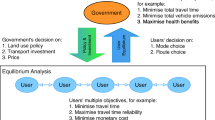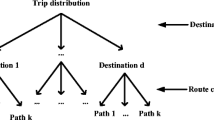Abstract
The interaction between the land use and transport in the urban context is a relevant issue in policy making. The connection between both systems arises since the former is causal of urban development while the latter is a consequence of it and significant contributor at the same time. One difficulty to unmask such interactions is to understand and determine the global system equilibrium, which is the matter of this paper. The households’ decisions, from their residential location to their travel and route choices, are described as a process of interdependent discrete choices that reflect the long term equilibrium. Consumers are assumed to optimize their combined residence and transport options, which are represented as a set of paths in an extended network that includes the transport system together with fictitious additional links that represents land use and location market. At equilibrium no household is better off by choosing a different option for residential location or by choosing a different set of trips’ destinations and routes. We study several alternative models starting from a simple case with fixed real estate supply and exogenous travel demand, to more complex situations with a real estate market, trip destination choices and variable trip frequencies. The equilibrium is characterized by an equivalent optimization problem which is strictly convex coercive and unconstrained. The optimality conditions for this optimization problem reproduce the transport equilibrium conditions as much as the land use equilibrium conditions. The approach provides a comprehensive characterization of the solution regarding existence and uniqueness, together with an algorithm to obtain the solution with well-defined convergence properties. The model is applicable to real size problems, with heterogeneous population and locations, as well as multiple trip purposes.
Similar content being viewed by others
References
Akamatsu T (1997) Decomposition of path choice entropy in general transportation networks. Transp Sci 31:349–362
Anas A (1981) Discrete choice theory, information theory and the multinomial logit and gravity models. Transp Res 17B:13–23
Alonso W (1964) Location and land use: towards a general theory of land rent. Harvard University Press, Cambridge, Massachusetts, USA
Baillon JB, Cominetti R (2006) Markovian traffic equilibrium. Math Prog 111:33–56 DOI 10.1007/s10107-006-0076-2
Beckmann M, McGuire CB, Winstein CB (1956) Studies in the economics of transportation. Yale University Press, New Haven
Ben-Akiva M, Lerman S (1985) Discrete choice analysis: theory and application to travel demand. MIT Press, Cambridge, Massachussetts
Boyce D, Mattsson L-G (1999) Models residential location choice in relation to housing location and road tolls on congested urban highway networks. Transp Res 33B:581–591
Briceño L (2006) Modelo integrado de transporte y uso de suelo: un enfoque de optimización en redes. Master’s Thesis, Universidad de Chile
Cepeda M, Cominetti R, Florian M (2006) A frequency-based assignment model for congested transit networks with strict capacity constraints: characterization and computation of equilibria. Transp Res B 40(6):437–459
Chang JS (2006) Models of the relationship between transport and land-use: a review. Transp Rev 26–23:325–350
Chang JS, Mackett R (2005) A bi-level model of the relationship between transport and residential location. Transp Res B 40:123–146
Cominetti R, Correa J (2001) Common-lines and passenger assignment in congested transit networks. Transp Sci 35(3):250–267
Daganzo CF (1982) Unconstrained extremal formulation of some transportation equilibrium problems. Transp Sci 16:332–360
Daganzo C, Sheffi Y (1977) On stochastic models of traffic assignment. Transp Sci 11:253–274
Dial RB (1971) A probabilistic multipath traffic assignment model which obviates path enumeration. Transp Res 5:83–111
De Cea J, Fernández JE (1993) Transit assignment for congested public transport systems: an equilibrium model. Transp Sci 27(2):133–147
Ellickson B (1981) An alternative test of the hedonic theory of housing markets. J Urban Econ 9:56–79
Fisk C (1980) Some developments in equilibrium traffic assignment. Transp Res 14B:243–255
Florian M, Hearn D (1999) Network equilibrium and pricing. In: Hall RW (ed) Handbook of transportation science. Kluwer, Norwell, pp 361–393
Fukushima M (1984) On the dual approach to the traffic assignment problem. Transp Res B 18:235–245
LeBlanc LJ, Morlok EK, Pierskalla WP (1975) An efficient approach to solving the road network equilibrium traffic assignment problem. Transp Res 9:309–318
Lowry I (1964) A model of Metropolis, Rand Corporation. Santa Monica, USA
Macgill SM (1977) Theoretical properties of biproportional matrix adjustments. Environ Plann A 9:687–701
Martínez F (1992) The Bid-Choice land use model: an integrated economic framework. Environ Plann A 15:871–885
Martínez F, Donoso P (2001) Modeling land use planning effects: zone regulations and subsidies. In: Hensher D (ed) Travel behaviour research, the leading edge. Pergamon, Elsevier, pp 647–658
Martínez F, Hurtubia F (2006) Dynamic model for the simulation of equilibrium states in the land use market. Networks and Spatial Economics 6:55–73
Martínez F, Henríquez R (2007) A random bidding and supply land use model. Transp Res B (in press)
Nagurney A, Dong J (2002) Urban location and transportation in the information age: a multiclass, multicriteria network equilibrium perspective. Environ Plann 29B:53–74
Ortúzar JD, Willumsen LG (1994) Modelling transport, Second edition. Wiley, Chichester
Roy J (2004) Spatial interaction modelling. a regional science context. Springer, Berlin
Wardrop J (1952) Some theoretical aspects of road traffic research. Proc Inst Civ Eng 1:325–378
Wilson A (1970) Entropy in urban and regional modelling. Pion, London, UK
Author information
Authors and Affiliations
Corresponding author
Rights and permissions
About this article
Cite this article
Briceño, L., Cominetti, R., Cortés, C.E. et al. An Integrated Behavioral Model of Land Use and Transport System: A Hyper-network Equilibrium Approach. Netw Spat Econ 8, 201–224 (2008). https://doi.org/10.1007/s11067-007-9052-5
Published:
Issue Date:
DOI: https://doi.org/10.1007/s11067-007-9052-5




